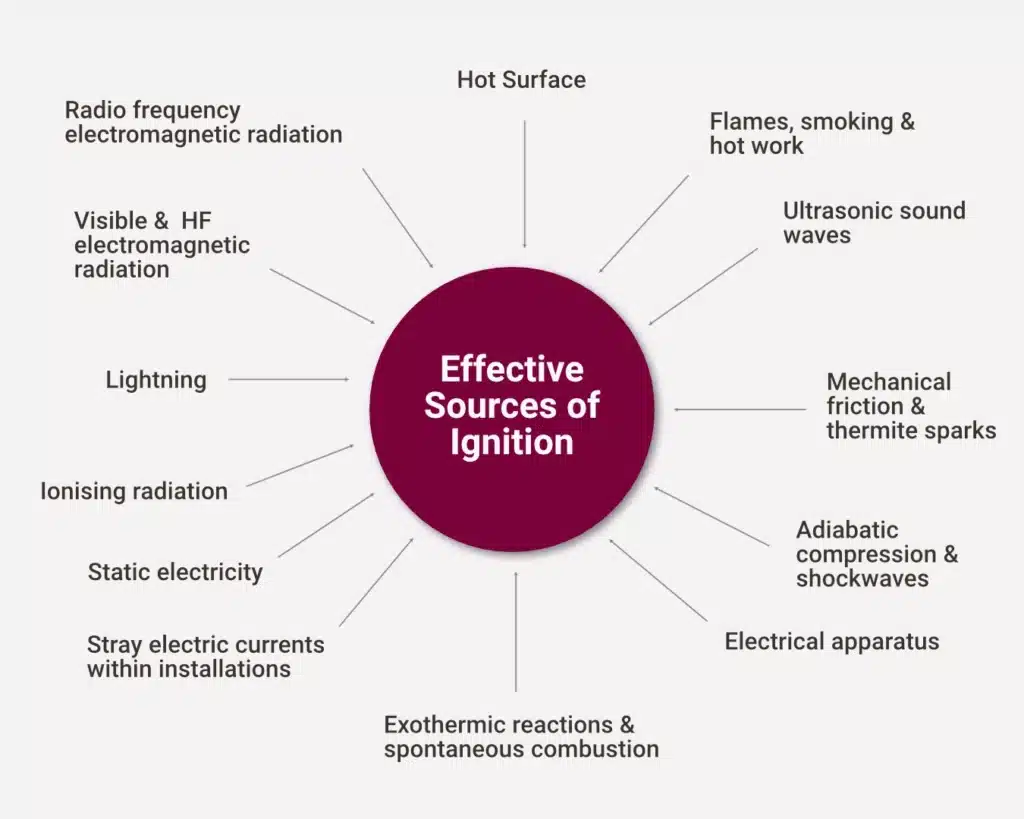Sigma-HSE provides ISO 17025 accredited testing on materials from industry for fire and explosion properties. We Provide detailed information on the properties of materials to confirm or establish a safe processing environment.
The process starts with expert advice to clients, ensuring the correct test package is selected for each part of the operation. This provides a complete portfolio of information on safe handling of a material. We focus on the ‘Basis of Safety’ for various operations on the material, from offloading/charging storage vessels, conveyance, milling, drying, treatment and final processing, through to packaging and downstream transportation.
What is a Basis of Safety?
A ‘Basis of Safety’ is built on a foundation of policies, procedures, and regulations that are designed to identify potential hazards and provide guidance on how to mitigate or eliminate those hazards. In the case of DSEAR/ATEX, this foundation includes the identification of potentially explosive atmospheres and the implementation of measures to prevent fires and explosions. This may include measures such as the use of intrinsically safe equipment, the use of protective measures such as barriers and enclosures, and the use of good housekeeping practices to prevent the build-up of potentially explosive materials.
To assess and reduce risk, a Basis of Safety must be determined for each unit operation. Sigma-HSE have made process safety testing as compact and comprehensive as possible by breaking it down into 3 main Basis of Safety approaches.
- Avoidance of Ignition Sources
- Explosion Protection and Prevention
- Thermal Decomposition
Flammability testing is required to complete your Basis of Safety. The data obtained from such tests will enable you to establish whether you can rely on, Explosion Prevention, Avoidance of Ignition Sources or Explosion Protection as your Basis of Safety. For example, if you are working with a higher MIT or LIT substance than the ATEX rated equipment can avoid ignition sources. This blog details the prerequisite test data preparation required when formulating a Basis of Safety.
What are the most common sources of ignition?

Explosion Prevention as a Basis of Safety
Explosion prevention measures are designed to prevent the ignition of potentially explosive materials, which could result in fires or explosions. There are a variety of explosion prevention measures that can be implemented, but this is dependent on the specific hazards present in the workplace.
Examples of explosion prevention measures include:
- The replacement of flammable materials with non-flammable materials.
- Avoidance of the accumulation of explosive dust via extraction systems and housekeeping.
- The removal of sources of ignition to levels that are reasonably practicable.
- Working outside flammable ranges determined by flammability testing.
- Working at oxygen levels below the materials limiting oxygen concentration
While every step may be taken to eliminate risks, mistakes and unexpected occurrences may still cause dust explosions. To ensure that your process is able to mitigate such an occurrence, Sigma-HSE can provide Explosion Severity data through our ISO 17025 accredited combustible dust testing laboratory.
Dust Combustibility Test
The first test that should be undertaken is the dust combustibility test. This is a preliminary test that estimates whether a particular dust or powder is flammable in nature. Essentially, if the dust does ignite, then it is combustible. If it does not, then it is not combustible. Most dusts are combustible, so don’t assume common / household materials are inert.
Flammable Limits and Concentration
The Lower Explosive Limit (LEL) is the lowest concentration at which a flammable gas or vapour will burn or explode if ignited. So, if any chemical below its LEL is handled and maintained it will not ignite.
The Upper Explosive Limit (UEL) is the highest concentration at which a flammable gas or vapour will burn or explode if ignited. This is due to over saturation of fuel and not enough oxidant. After rigorous sample data is collected from the test material, and if that material is between its LEL and UEL, then we can say that there is potential for the generation of an explosive atmosphere.
Avoidance of Ignition Sources as a Basis of Safety
The avoidance of ignition sources approach tests materials to determine how sensitive they are to specific ignition sources. This may include electrostatic discharges, mechanical sparks and hot surfaces. To be able to rely on the avoidance of ignition sources as a Basis of Safety, it is critical to understand just how sensitive your materials are to select suitable equipment.
This avoidance of ignition sources should be used where explosion protection or prevention cannot be applied. This could include the charging/discharging of vessels from sacks, IBC’s, FIBC’s, some conveying systems, milling or sieving operations and tabletting.
Auto-Ignition Temperature (AIT)
Auto-Ignition Temperature (AIT) will determine the temperature at which a liquid or gaseous material will ignite. Therefore, testing is completed so that a suitable temperature class of ATEX rated equipment can be determined. Resultingly, the temperature class of equipment must be lower than the AIT value for the avoidance of ignition sources as the basis of safety.
Minimum Ignition Temperature (MIT) and Layer Ignition Temperature (LIT)
The Minimum Ignition Temperature & Layer Ignition Temperature are used to determine the temperature at which ignition will occur. This value may then be used to select an appropriate temperature class of equipment once a safety factor is included.
The MIT of a material is the highest non ignition temperature of the material in a dust cloud. The LIT is the lowest ignition temperature required to ignite a 5mm thick dust layer.
These two test data properties are once again needed to decide what equipment must be installed in hazardous areas where the avoidance of ignition sources has been chosen as the basis of safety.
Two thirds of the MIT value are used alongside a minus 75°C ignition value for the LIT. As an example, if the MIT value is 300°C the safe operating temperature would be 200°C. The LIT safety factor would then be 225°C. The lowest value is then used to determine the safest temperature – in this case it would be the MIT temperature which would result in the use of equipment with an ATEX rating of T3.
Electrostatic Properties
A sub-group of Avoidance of Ignition Sources are the electrostatic properties of the materials being during process conditions. Highly insulating materials and/or isolated conductors will become charged in most operations. As an example, operators can become charged by induction and if not earthed, they can become a mechanism for an electrostatic spark discharge. Testing may vary from the electrostatic properties of the materials being processed, electrostatic properties of containers or transfer mediums, floors and PPE such as shoes and gloves. Examples of appropriate tests include:
- Volume / Surface Resistivity
- Charge Relaxation Time
- Chargeability
This test data is useful for operations that involve powder movement or storage such as pneumatic conveying, blending, milling and big bag storage.
Explosion Protection as a Basis of Safety
Explosion protection measures are designed to protect against the effects of a fire or explosion. There are a variety of explosion protection measures that can be implemented, but again, this is dependent on the specific hazards present in the workplace.
Examples of explosion protection measures include:
- Installation of pressure and explosion proof vessels.
- Installation of explosion suppression systems.
- Installation of explosion venting systems.
Explosion Protection test data can help to determine whether containment, venting or suppression systems can be or are being applied safely.
Explosion Severity (Pmax & Kst) (20L)
The Pmax and Kst test is conducted to determine the maximum pressure (Pmax), maximum rate of pressure rise (dP/dt)max and the dust constant Kst value of an ignited powder, dispersed in the air, as a dust cloud. Data generated by the explosion severity test is predominantly used for the design of explosion protection systems (venting, containment, or suppression) or to confirm if a material is appropriate for processes within an established explosion protection system.
Minimum Explosive Concentration (MEC) and Limiting Oxygen Concentration (LOC)
MEC (Minimum Ignition Energy) and LOC (Limiting Oxygen Concentration) tests are critical tests in explosion protection. MEC testing determines the minimum energy required to ignite a flammable gas or vapor mixture in air. LOC testing, on the other hand, determines the minimum oxygen concentration required for ignition of a flammable gas or vapor mixture in air.
MEC and LOC tests are essential in explosion protection as they determine the limits within which explosions can occur. MEC and LOC testing helps to identify the potential risks of explosion and implement appropriate safety measures to mitigate the risk. It is crucial to ensure that the equipment and materials used in hazardous areas are designed and manufactured to withstand the explosion risks within the specific limits identified by MEC and LOC tests.
Conclusion
Process safety testing is crucial for establishing a Basis of Safety to ensure the safe handling of materials and the prevention of fire and explosion risk in the workplace.
Sigma-HSE focuses on three main approaches: Avoidance of Ignition Sources, Explosion Protection and Explosion Prevention as a suitable Basis of Safety. Each approach requires specific testing packages to assess and reduce risk. By conducting tests such as Dust Combustibility, Minimum Explosive Concentration, Limited Oxygen Concentration, Flammable Limits and Concentration, and Auto-Ignition Temperature, Sigma-HSE can provide you with comprehensive information to establish safe processing environments.
The importance of testing lies in its ability to identify potential combustible dust hazards and provide guidance on how to mitigate or eliminate them. Sigma-HSE’s ISO17025 quality systems ensure that all results are accurate with traceable test data.
However, data alone is only one part of a process safety plan and must be used with both caution and expertise for it to be effective. Interpretation and implementation are where Sigma-HSE consulting engineers and process safety experts can also bring a wealth of expertise.



